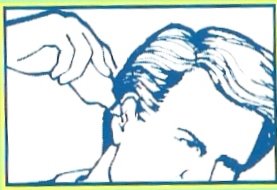When the group asked me to speak -- three months ago -- I told them my talk would be along the lines of "Public Radio: Behind the Scenes" - sort of a sneak peak into the always glamorous world of public radio reporting (The tote bags! Diane Rehm! Sylvia Poggioli!). But as the three months passed, and I largely forgot about my commitment, and then remembered again, "Public Radio: Behind the Scenes" sounded even less interesting than those non-shows they insist on running on the top half of the TV Guide cable channel.
So I settled on an "Anatomy of a Feature Story" concept, in which I walked the class members through the making of a feature story -- from its genesis to conceptualizing the scenes, deciding who to interview, what natural sounds to include, and finally, what it sounds like when it's written and mixed together (yes, I thought that would be more interesting than the other idea). I used a piece I produced for NPR's Day to Day some weeks ago about the doctor gap in Arizona.
The hour-long talk went pretty well - as noted, the class asked a lot of questions. But one element got far more attention than I expected - the fact that the idea for the story originated with a press release from Arizona State University (where the doctor gap study was conducted). Some of the participants were floored that I would actually let a humble press release dictate the news I cover.
Frankly, I used this press release-initiated story because it was easier to bring the release along as a handout than it would have been to bring a contact with the US Forest Service, or the expertise developed from the rich body of work performed by our reporters. But it made for a good way to illustrate the difference between what's written in a press release and the broader, more contextual (and more interesting) material that comes across in a produced feature story.
Plus, without press releases like the one the 19 Minutes inbox just received, the world would never know that:
This was especially interesting to me, since I'm playing in a charity golf tournament tomorrow. The release's details include this illuminating paragraph:
WaggleWeight.com Unveils a New Golf Club Specification to Help Golfers
GLENDALE HEIGHTS, Ill., Sept. 15, 2005 -- A modernization of swingweight, which has literally gone unchanged since the 1930s, WaggleWeight.com has disclosed an advanced golf club specification, aptly named Waggle Weight. This long-overdue betterment will help promote improved swinging for players through a procedure previously unavailable.
In a report issued by founder Bill Kostuj, the golf professional reveals that while swingweighting can indeed affect one's entire golf swing, including its overall rhythm and timing, the parameter's foundation is in fact traced back to a golfer's waggling motion during the pre-swing. "This is where swingweight's 14-inch fulcrum balance comes into play," notes Kostuj, adding, "Nearly a century of puzzlement concerning the application of that proven, yet mysterious golf club parameter is finally put to rest. Consistent sensations of any golf club's 'heft' from the fullest, hardest of swings down to the smallest, most subtle chips (and everything in between) are crucial toward successful play, and such a specification can only be achieved within one's swing preparation." With this knowledge comes the realization that far too many golfers cannot adequately exploit the present system. As can be noted by observing players' pre-swing movements, swingweight's configuration may actually be hurting more golf swings than it is helping. No level of playing ability is immune from adverse effects if the parameter is poorly fit.These details (fulcrum balance? golf club parameters?) are so far beyond the golfing comprehension of the 19 Minutes staff that we're going to do what we normally do at charity golf tournaments: Hope the official scorer is in a charitable mood.




No comments:
Post a Comment